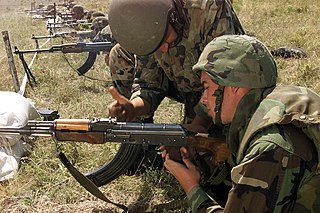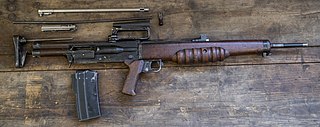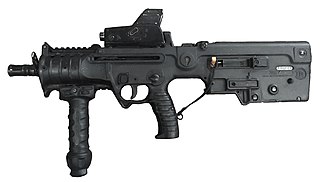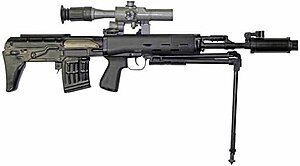
A squad automatic weapon (SAW), also known as a section automatic weapon or light support weapon (LSW), is a man-portable automatic firearm attached to infantry squads or sections as a source of rapid direct firepower. Weapons fulfilling this role can be light machine guns, or modified selective-fire rifles fitted with a heavier barrel, bipod and a belt/drum-fed design.

The SA80 is a British family of 5.56×45mm NATO service weapons used by the British Army. The L85 Rifle variant has been the standard issue service rifle of the British Armed Forces since 1987, replacing the L1A1 Self-Loading Rifle. The prototypes were created in 1976, with production of the A1 variant starting in 1985 and ending in 1994. The A2 variant came to be as the result of a significant upgrade in the early 2000s by Heckler & Koch and remains in service as of 2023. The A3 variant was first issued in 2018 with several new improvements.
The FN FAL is a battle rifle designed in Belgium in 1953 by Dieudonné Saive and manufactured by FN Herstal.

The Steyr AUG is an Austrian bullpup assault rifle chambered for the 5.56×45mm NATO intermediate cartridge, designed in the 1960s by Steyr-Daimler-Puch, and now manufactured by Steyr Arms GmbH & Co KG.

An automatic rifle is a type of autoloading rifle that is capable of fully automatic fire. Automatic rifles are generally select-fire weapons capable of firing in semi-automatic and automatic firing modes. Automatic rifles are distinguished from semi-automatic rifles in their ability to fire more than one shot in succession once the trigger is pulled. Most automatic rifles are further subcategorized as battle rifles or assault rifles.

The IWI Tavor, previously designated as the Tavor TAR-21, is an Israeli bullpup assault rifle chambered in 5.56×45mm NATO, designed and produced by Israel Weapon Industries (IWI). It is part of the Tavor family of rifles, which have spawned many derivatives of the original design.

Selective fire, or select fire, is the capability of a weapon to be adjusted to fire in semi-automatic, fully automatic, and/or burst mode. The modes are chosen by means of a selector switch, which varies depending on the weapon's design. Some selective-fire weapons have burst fire mechanisms to limit the maximum number of shots fired automatically in this mode. The most common limits are two or three rounds per trigger pull. Fully automatic fire refers to the ability for a weapon to fire continuously until either the feeding mechanism is emptied or the trigger is released. Semi-automatic refers to the ability to fire one round per trigger pull.

The FN F2000 is a 5.56×45mm NATO bullpup rifle, designed by FN Herstal in Belgium. Its compact bullpup design includes a telescopic sight, a non-adjustable fixed notch and front blade secondary sight. The weapon has fully ambidextrous controls, allowed by a unique ejection system, ejecting spent cartridge casings forward and to the right side of the weapon, through a tube running above the barrel. The F2000 made its debut in March 2001 at the IDEX defence exhibition held in Abu Dhabi, in the United Arab Emirates.

The EM-2, also known as Rifle, No.9, Mk.1 or Janson rifle, was a British assault rifle. It was briefly adopted by British forces in 1951, but the decision was overturned very shortly thereafter by Winston Churchill's incoming government in an effort to secure NATO standardisation of small arms and ammunition. It was an innovative weapon with the compact bullpup layout, built-in carrying handle and an optical sight.

The L64 was an intermediate calibre British bullpup layout prototype assault rifle developed in the 1970s. At one time it was known as the 4.85 Individual Weapon, a reference to the calibre of the bullet it fired.

A designated marksman rifle (DMR) is a modern scoped high-precision rifle used by infantry in the designated marksman (DM) role. It generally fills the engagement range gap between a service rifle and a dedicated sniper rifle, at around 300–600 metres (330–660 yd).

Rotating bolt is a method of locking the breech of a firearm closed for firing. Johann Nicolaus von Dreyse developed the first rotating bolt firearm, the "Dreyse needle gun", in 1836. The Dreyse locked using the bolt handle rather than lugs on the bolt head like the Mauser M 98 or M16. The first rotating bolt rifle with two lugs on the bolt head was the Lebel Model 1886 rifle. The concept has been implemented on most firearms chambered for high-powered cartridges since the 20th century.

The Vepr is the first Ukrainian-made assault rifle, designed in 1993–1994 by the State Space Agency of Ukraine and announced in 2003. It is one of several bullpup conversions of the conventional Russian AK-family design, along with the Polish Kbk wz. 2005 Jantar, the Chinese Norinco Type 86S, the Russian OTs-14 Groza and the Finnish Valmet M82.
The LAPA FA-03 was a bullpup assault rifle designed in Brazil by the company LAPA, and developed by its owner, Nelmo Suzano (1930-2013). The acronym FA-03 stands for "Fuzil de Assalto Modelo 03".

The Bushmaster M17S is a semi-automatic bullpup rifle that was manufactured by Bushmaster Firearms International from 1992 until 2005.

The IWI Galil ACE is a series of assault rifles and battle rifles originally developed and manufactured by Israel Weapon Industries (IWI). It is produced in three different calibres: 5.56×45mm NATO, 7.62×39mm and 7.62×51mm NATO.
The EMER K-1, sometimes known as the EMER K1 or EMERK-1, was a prototype bullpup assault rifle made in Myanmar by the Electrical Mechanical and Engineering Corps (EMEC). Reverse engineered in 1995 from the Chinese QBZ-97 assault rifle, the EMER K-1 was prone to stoppage.

The L1A1 Self-Loading Rifle (SLR), also known by the initial Canadian designation C1, or in the U.S. as the "inch pattern" FAL, is a British version of the Belgian FN FAL battle rifle. The L1A1 was produced under licence and adopted by the armed forces of the United Kingdom, Australia, Canada, India, Jamaica, Malaysia, New Zealand, Rhodesia and Singapore.

The IWI X95 is an Israeli bullpup assault rifle designed and produced by Israel Weapon Industries (IWI) as part of the Tavor rifle family, along with the Tavor TAR and the Tavor 7. IWI US offers the rifle in semi-automatic only configuration as the 'Tavor X95'.

The Kel-Tec RDB is a bullpup carbine offered in 5.56×45mm NATO semi-automatic rifle, manufactured by Kel-Tec Industries of Florida. It uses a rotary bolt with a spring loaded ejector and an extractor facing down, ejecting spent shell casings downward, allowing easy ambidextrous use.




























